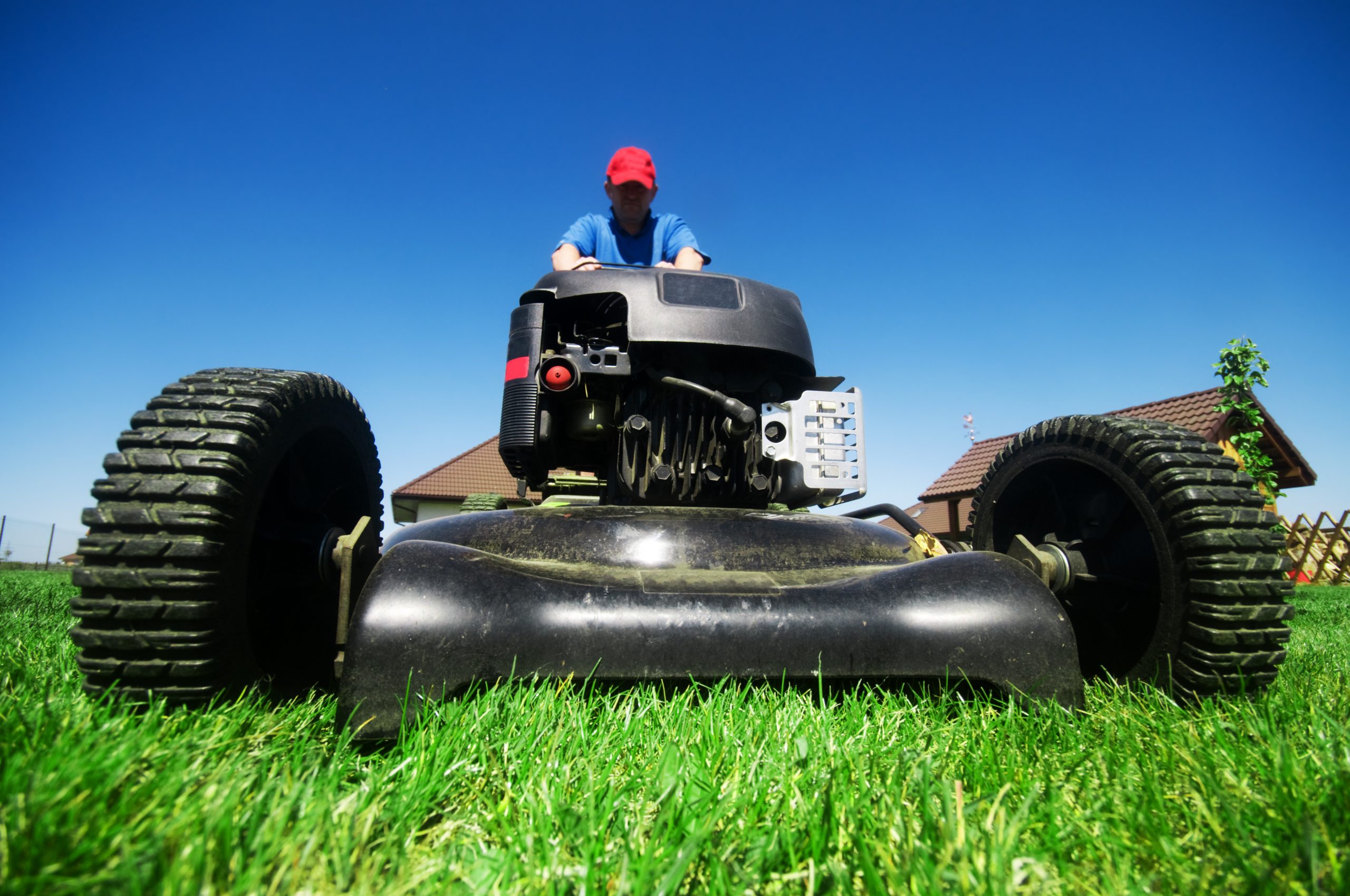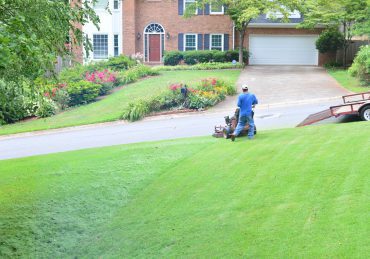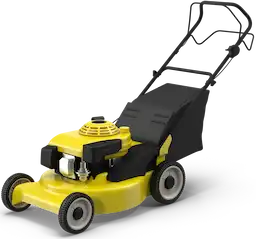Identifying and repairing grub damage in your lawn is essential for maintaining its health and appearance. Look for sudden brown patches that resemble drought stress and a spongy ground texture, which are telltale signs of grubs. Conduct a turf test by lifting sections of sod and counting the grubs; five or more per square foot indicates a significant problem. Uncovering how to efficiently repair this damage and prevent further issues is important for your lawn’s vitality.
First Signs of Grubs on Your Lawn (And Why You Shouldn’t Ignore Them)
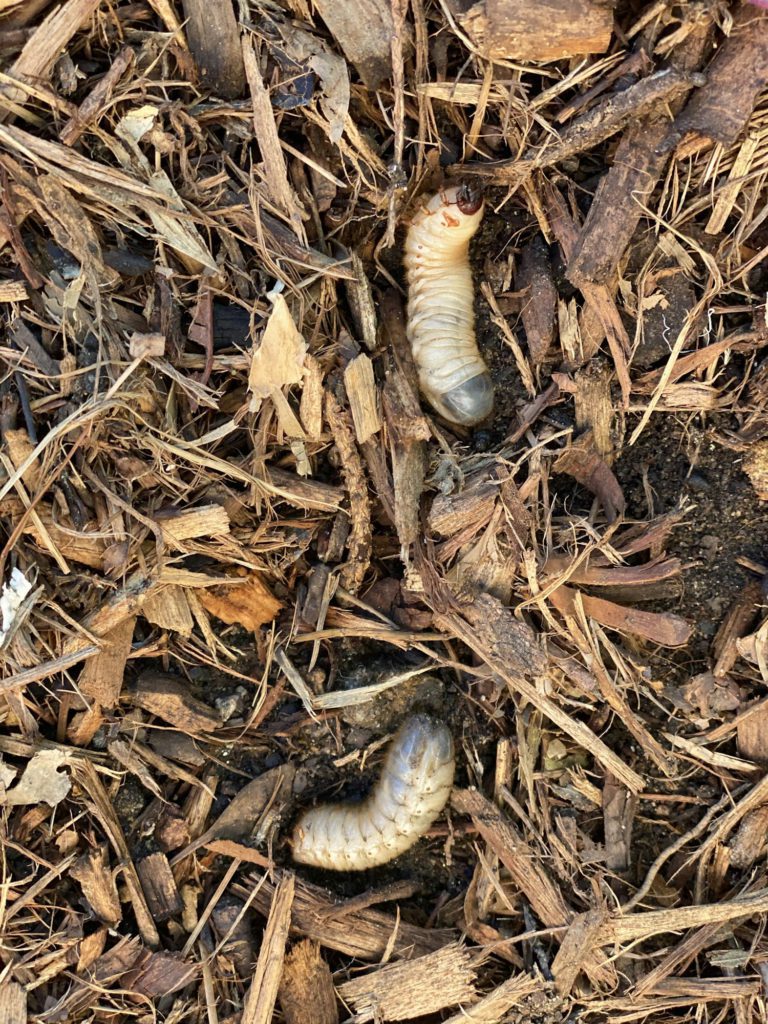
You shouldn’t overlook the sudden appearance of brown patches spreading across your lawn, as they often indicate grub activity beneath the surface.
A spongy texture that mimics a worn carpet suggests compromised root systems, leaving your grass vulnerable and easily uprooted.
Furthermore, increased visits from birds and skunks act as natural warnings of a grub infestation, signaling it’s time for a thorough inspection and prompt action.
Brown Patches That Spread Without Warning
While often overlooked in its early stages, the sudden appearance of brown patches spreading across your lawn can be an ominous sign of grub infestation. Lawn grub damage results from these pests feeding on grass roots, causing turf decline. To confirm grub infestation, look for increased wildlife activity and use the following table for guidance:
| Observation | Indication |
|---|---|
| Brown patches | Possible grub presence |
| Soft, spongy areas | Root damage by grubs |
| Wildlife digging | Grubs attracting scavengers |
| More than 5 grubs in soil | Immediate treatment needed |
Spongy Ground That Feels Like a Worn Carpet
One of the earliest indicators of grub activity in your lawn is a spongy ground that resembles a worn carpet. This spongy underfoot sensation occurs when white grubs sever grass roots, compromising the turf’s structural integrity.
As a result, the surface might also exhibit a grub damage look, with brown or yellow spots appearing. These signs shouldn’t be ignored, as they signal root damage that, if left unchecked, can deteriorate further, complicating your restoration efforts.
Birds and Skunks: Nature’s Grub Detectives
Although often underestimated, birds and skunks are invaluable allies in the early detection of grub infestations within your lawn. Increased activity from these creatures usually signals a buffet of grubs lurking beneath the surface.
When birds or skunks dig and overturn patches of grass, they’re targeting areas rich with these larvae. Such activity indicates potential lawn damage from grubs, as their feeding weakens the turf. Ignoring these signs can escalate the problem, exacerbating lawn damage.
Consequently, monitor your lawn for unusual wildlife activity, spongy textures, and brown patches. Quick identification and action prevent further degradation of your grass.
What Does Grub Damage Look Like Up Close?
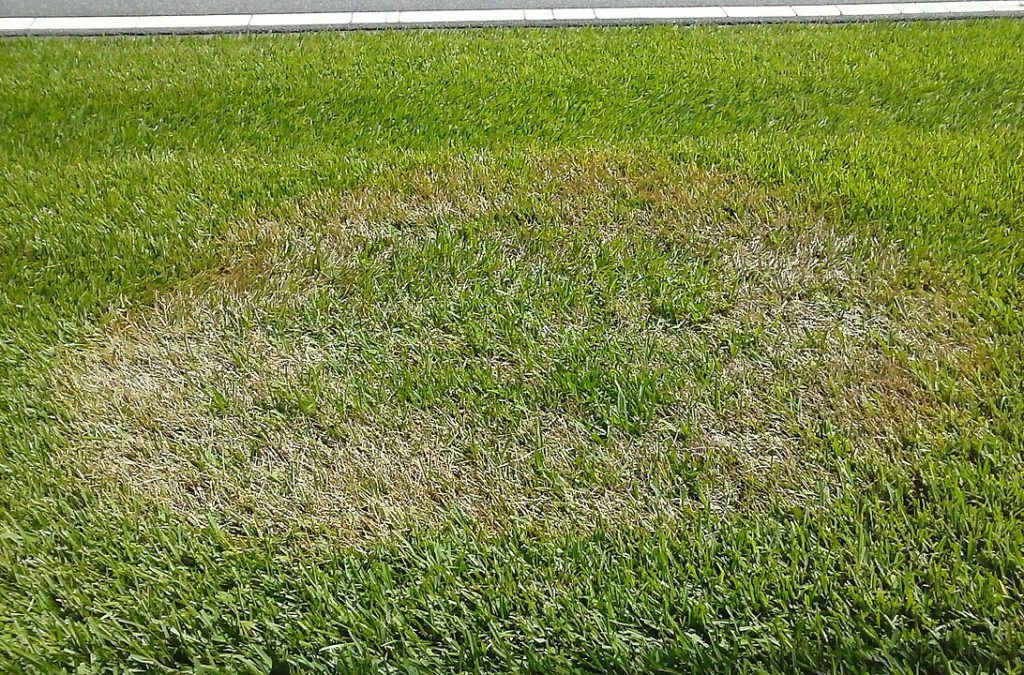
Grub damage becomes unmistakable when you closely inspect your lawn. You’ll notice brown, patchy areas that resemble drought stress but aren’t related to water shortage. The grass feels spongy underfoot, indicating root damage, and dead patches can be easily lifted as loose sod due to compromised roots.
| Sign | Description | Indicator |
|---|---|---|
| Brown Patches | Similar to drought stress | Grub presence |
| Spongy Texture | Underfoot feel due to root damage | Check for grubs |
| Loose Sod | Easily rolled back, sign of root issues | Active grubs |
Increased wildlife activity is another clue, as animals search for these pests.
Grub Identification Test
To perform the 30 cm turf test, select an area of brown or damaged grass and carefully lift the sod to examine the soil beneath.
Count the number of grubs, off-white larvae with darker heads and a curled C-shape, within this section; finding more than five indicates a problematic infestation.
Conduct this test after heavy rain for ideal soil conditions, ensuring accurate detection and timely intervention.
How to Perform the 30 cm Turf Test
Performing the 30 cm turf test is an essential step in diagnosing grub damage in your lawn effectively.
To determine if grubs have infested your lawn, dig a 30 cm by 30 cm patch of grass in discolored or spongy areas. Lift the sod carefully to expose the soil. Grubs, measuring 1-3 cm, will curl into a C shape when disturbed. A count exceeding five grubs indicates infestation.
Conduct the test after rain or irrigation for ease of digging and visibility. Spotting these pests early is vital for proper lawn care, ensuring your lawn remains healthy and vibrant.
How Many Grubs Is Too Many?
Ever wonder how many grubs are too many for your lawn to handle? Conduct a grub identification test by digging a 30 cm patch of brown or dead grass. If you find more than five grubs, it’s time for grub control measures.
These pests, typically 1-3 cm long, are off-white with darker heads and curl into a C shape when disturbed. Signs of a grub issue include spongy lawn texture and discoloration.
Detecting and addressing grub infestations early is crucial. Left unchecked, grubs can severely damage your lawn’s root system, leading to further decay and extensive dead grass patches.
How to Repair Grub Damage in Your Lawn
To repair grub-damaged areas, start by removing loose, dead grass and preparing the soil for new growth.
Decide between using sod or seed based on the size of the bare patches; sod is ideal for large areas needing quick coverage, while seed is suitable for smaller spots.
Guarantee proper recovery by maintaining a consistent watering schedule, keeping the soil moist to support seed germination and sod establishment.
Remove and Reseed Bare Patches
When addressing the bare patches left by grub damage in your lawn, start by thoroughly raking out any loose, dead grass to clear the area.
Next, gently loosen the topsoil to a depth of ¼ to ½ inch, ensuring a suitable environment for reseeding.
Apply a high-phosphorus fertilizer like bone meal to boost root development.
Evenly distribute grass seeds at a density of 5-7 seeds per square inch over the prepared soil.
To promote successful germination, maintain consistent moisture by watering the area 3-4 times daily until the new grass establishes itself, ensuring a lush, healthy lawn regrowth.
When to Use Sod vs. Seed
After addressing the bare patches by removing dead grass and preparing the soil, it’s important to decide whether to use sod or seed to repair grub-damaged areas. Choose sod for instant coverage, especially in severely damaged spots where soil conditions hinder seeding. Opt for grass seed in less damaged areas to foster deeper roots and a fuller lawn over time.
| Factor | Sod | Grass Seed |
|---|---|---|
| Coverage speed | Immediate | Gradual |
| Soil condition | Best for compromised soil | Best for minor damage |
| Root growth | Shallow initially | Promotes deeper roots |
Consider the extent of damage and desired outcomes when choosing.
Watering & Recovery Tips for Damaged Turf
Begin revitalizing grub-damaged turf by guaranteeing consistent watering to facilitate recovery. Aim to water the affected area 3-4 times daily until new grass seeds germinate.
This frequent watering keeps the soil moist, promoting healthy lawn growth. Once the new grass reaches about 2 inches in height, adjust the watering schedule to maintain ideal soil moisture.
Before seeding, apply a high-phosphorus fertilizer like bone meal to encourage robust root development. Rake out any loose, dead grass and aerate the soil to enhance nutrient absorption and seed-to-soil contact.
Regularly monitor for further grub activity to guarantee successful lawn recovery.
Controlling the Grub Population Before It Spreads
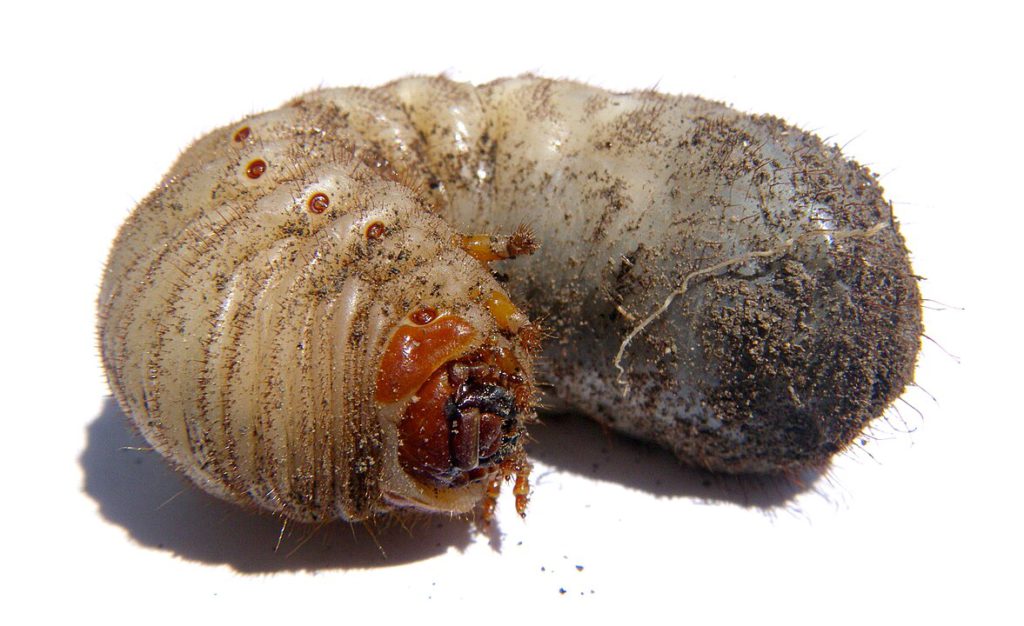
To effectively manage the grub population before it spreads, consider implementing natural control options such as beneficial nematodes, ideally applied from late summer to early fall when grubs are most active.
Timing is essential for grub-specific treatments; applying them during peak feeding times maximizes their impact.
Furthermore, maintain a robust lawn through consistent watering and proper mowing to discourage beetle activity and subsequent egg-laying.
Natural Grub Control Options (Like Nematodes)
While chemical treatments can be effective, employing natural grub control options like beneficial nematodes offers a sustainable approach to managing lawn pests.
Expert advice suggests applying these microscopic roundworms in late summer to early fall when grubs are actively feeding. Nematodes parasitize grubs without harming beneficial insects or the environment.
To guarantee their effectiveness, maintain moist soil conditions, as nematodes need moisture to move and locate grubs. Regularly monitor for signs of grub activity such as discoloration and increased wildlife presence.
This preventive measure can greatly reduce infestations, promoting healthier grass and minimizing reliance on chemical treatments.
When to Apply Grub-Specific Treatments
Natural grub control options like nematodes provide a sustainable approach, but sometimes more targeted interventions are necessary to control grub populations effectively.
Grub-specific treatments should be applied in late spring, before beetles lay eggs, ensuring larvae don’t develop in your soil.
Watch for early signs like grass turning yellow and increased animal activity to time treatments accurately.
Perform a grub count test by digging up a patch of discolored grass; if you find more than five grubs per square foot, it’s time for treatment.
Strengthen your lawn with regular maintenance and deep watering to enhance treatment effectiveness and resilience.
Preventative Lawn Care to Discourage Beetles
Although maintaining a healthy lawn requires diligence, adopting preventative lawn care practices is key to discouraging beetles and controlling grub populations before they spread.
Start by promoting deep grass roots, which improve resistance against grubs. Guarantee your grass grows thickly to create a natural barrier, deterring beetle egg-laying.
Regularly monitor for grub signs, like patchy grass and increased wildlife activity, for early intervention. Consider introducing beneficial nematodes to naturally reduce grubs.
Avoid over-fertilization, as excessive nutrients can attract beetles.
What Does a Lawn With Grubs Look Like vs. Other Lawn Issues?
Have you noticed brown, patchy areas marring your once lush lawn? Grubs might be the culprits behind these unsightly patches of grass.
A grub-infested lawn often feels spongy underfoot, unlike drought-stressed grass, which remains firm. Grub damage also allows you to easily pull up grass like a carpet, revealing root damage.
Increased wildlife activity, such as birds or raccoons digging, further signals a grub problem. Lift affected sod, and if you find white larvae, it’s a clear infestation sign.
Unlike diseases that uniformly affect grass, grub issues create distinct patchiness, helping you distinguish between different lawn problems.
Still Seeing Grub Damage on Your Lawn? LawnGuru Can Help
If you’re still seeing grub damage despite your efforts, it’s time to contemplate professional intervention from LawnGuru.
Grub infestations can be tricky; these pests feed on grass roots, causing brown, patchy areas that feel spongy. Even after reseeding or aerating, persistent damage might signal a deeper problem.
LawnGuru offers specialized lawn care services to effectively manage grubs, ensuring your lawn’s health. We’ll assess the infestation, apply targeted treatments, and implement a tailored maintenance plan to prevent recurrence.
With expert intervention, your lawn can thrive, transforming from a patchy landscape to a lush, vibrant oasis, free from grub damage.

